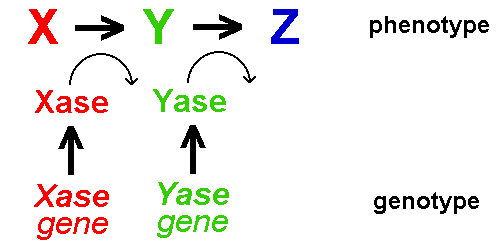
In Principle: Proteins are the products of genes.
Proteins catalyze biochemical reactions.
Such reactions produce phenotypes, either directly or indirectly.
Different alleles produce different phenotypes
Interaction between alleles in diploid organisms is the subject matter of Classical Genetics
Biochemical Basis of Human
Genetic Diseases
Diploid organisms have two alleles at each gene locus, one from each parent
Interactions between alleles at a locus are the subject matter of classical (Mendelian) genetics
"Online Mendelian Inheritance in Man" (OMIM) database
Examples from human biochemical genetics: "Inborn errors of metabolism"
First three involve disruptions of phenylalanine metabolism
Phenylketonuria (PKU) (Folling 1934) (OMIM citation 261600)
phenylalanine & by-products accumulate in Central Nervous System
 mental
retardation
mental
retardation A defect of phenylalanine hydroxylase
phenyalanine metabolized to phenylpyruvic acid in alternative pathway
Detection & treatment
biochemical testing of newborns: Guthrie Test [Homework #18]
phenylalanine-restricted diet corrects inborn condition (Euphenics)
Maternal PKU occurs in children high fetal [phe] born to treated, asymptomatic mothers
[ Further information on PKU & related Inborn Errors of Metabolism ]
PKU arises from genetic variation at the Phenylalanine Hydroxylase (PAH) gene locus
Important: This gene is not a gene "for" PKU: it is a gene "for" PAH
Diploid humans each have two alleles at this locus
Allelic variants produce different levels of PAH activity
Consider diploid combinations of three (hypothetical) alleles: A, B, & C :
| Phenotypic consequences of
allelic interactions at the PAH locus |
| Genotype |
PAH Activity |
[phe] uM |
PKU Phenotype |
| AA |
100% |
60 |
Standard (non-PKU) |
| AB |
30% |
120
|
Standard (non-PKU) |
| CC | 5% | 200 ~ 300 |
Hyperphenylalanemia:
no special diet required |
| BB |
0.3% |
600 ~ 2400 |
Classic PKU: special diet required |
[Alleles B & C) arise from DNA mutations in the PAH gene]
PKU was originally described as a "recessive" genetic disease: What does this mean?
AB genotype shows same PKU phenotype as AA genotype: non-PKU
A allele shows haplosufficiency:
one "allele's worth" of product is sufficient for standard phenotype
or, expression of A allele "masks" expression of B allele
A is described as "dominant" to B in influencing PKU phenotype
B is described as "recessive" to A
and BB phenotype is different from AA / AB phenotype: PKU
but PAH activity phenotype of AB is intermediate between AA & BB
AB phenotype is closer to BB than AA (0% < 30% << 100%)
Is B therefore an "incomplete dominant" to A ?
and B produces a higher [phe] phenotype than A:
Is B therefore "dominant" to A ?
Distinguish molecular versus phenotypic expression (Homework #19)
| Homework #20 Predict the
PAH activity,
[phe], & PKU phenotypes of
the AC
and CB
genotypes.
Explain your
reasoning.Would you expect to find a dominant mutation in this pathway? Why or why not? What might be the phenotypic consequence of such a mutation? |
Other molecular disorders of Phenylalanine metabolism
Alkaptonuria (OMIM 203500): an illustration of "Classical" versus "Reverse" Genetics
an introduction to Ascertainment Bias
Oculo-cutaneous Albinism (OMIM 203100)
All text material © 2024 by Steven M. Carr
